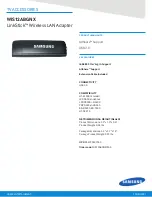
344 Administering Advanced Zoning
Zone types
Table 80
summarizes the types of Zoning.
Table 80
Types of Zoning
Zone type
Description
Storage-based Storage units typically implement LUN-based Zoning, also called
LUN
masking
. LUN-based Zoning limits access to the LUNs on the storage port to
the specific WWN of the server HBA. It is needed in most SANs. It functions
during the probe portion of SCSI initialization. The server probes the storage
port for a list of available LUNs and their properties. The storage system
compares the WWN of the requesting HBA to the defined zone list, and
returns the LUNs assigned to the WWN. Other LUNs on the storage port are
not made available to the server.
Host-based
Host-based Zoning can implement WWN or LUN masking.
Fabric-based
Fabric switches implement fabric-based Zoning, in which the zone members
are identified by WWN or port location in the fabric. Fabric-based Zoning is
also called
name server-based
or
soft
Zoning.
When a device queries the fabric name server, the name server determines
the zones in which the device belongs. The server returns information on all
members of the zones in the fabric to the device. Devices in the zone are
identified by node WWN, port WWN, or (domain, port) of the switch to
which the device is connected.
The primary approaches to fabric-based Zoning are summarized in
Table 81
.
Table 81
Approaches to fabric-based Zoning
Zoning
approach
Description
Single HBA
Zoning by single HBA most closely re-creates the original SCSI bus. Each
zone created has only one HBA (initiator) in the zone; each of the target
devices is added to the zone. Typically, a zone is created for the HBA and
the disk storage ports are added. If the HBA also accesses tape devices, a
second zone is created with the HBA and associated tape devices in it. In
the case of clustered systems, it could be appropriate to have an HBA from
each of the cluster members included in the zone; this is equivalent to having
a shared SCSI bus between the cluster members and presumes that the
clustering software can manage access to the shared devices. In a large
fabric, Zoning by single HBA requires the creation of possibly hundreds of
zones; however, each zone contains only a few members. Zone changes
affect the smallest possible number of devices, minimizing the impact of an
incorrect zone change. This Zoning philosophy is the preferred method.
Application
Zoning by application typically requires Zoning multiple, perhaps
incompatible, operating systems into the same zones. This method of Zoning
creates the possibility that a minor server in the application suite could
disrupt a major server (such as a Web server disrupting a data warehouse
server). Zoning by application can also result in a zone with a large number
of members, meaning that more notifications, such as registered state
change notifications (RSCNs), or errors, go out to a larger group than
necessary.
Summary of Contents for AE370A - Brocade 4Gb SAN Switch 4/12
Page 18: ...18 ...
Page 82: ...82 Managing user accounts ...
Page 102: ...102 Configuring standard security features ...
Page 126: ...126 Maintaining configurations ...
Page 198: ...198 Routing traffic ...
Page 238: ...238 Using the FC FC routing service ...
Page 260: ...260 Administering FICON fabrics ...
Page 280: ...280 Working with diagnostic features ...
Page 332: ...332 Administering Extended Fabrics ...
Page 414: ...398 Configuring the PID format ...
Page 420: ...404 Configuring interoperability mode ...
Page 426: ...410 Understanding legacy password behaviour ...
Page 442: ...426 ...
Page 444: ......
Page 447: ......















































